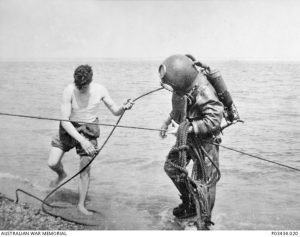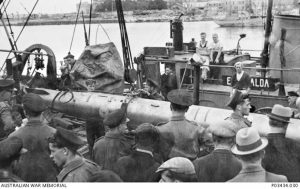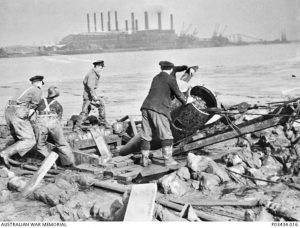- Author
- A.N. Other
- Subjects
- Biographies and personal histories, History - WW2
- Tags
-
- RAN Ships
- None noted.
- Publication
- March 2017 edition of the Naval Historical Review (all rights reserved)
By Hector Donohue
When Lieutenant Commander Leon Goldsworthy GC, DSC, GM, MID died in 1994, the New York Times published an obituary which included the following: Lieut. Comdr. Leon Goldsworthy, a specialist in the disposal of enemy explosive devices from Australia who helped the American Navy during the invasion of the Philippines in World War II, died on Aug. 7 in South Perth, Australia. He was 85. Commander Goldsworthy was Australia’s most highly decorated naval officer in that war…Later that year, he was lent to the American Navy for the invasion of the Japanese-occupied Philippines and applied his skills to Japanese mines and booby-traps.
In researching a recent book, I co-authored with Jake Linton, United and Undaunted – the First 100 Years, I came across Goldsworthy’s personal papers held by the Australian War Memorial and realised that there are a number of popular misconceptions published in contemporary accounts of his wartime exploits. In this article I provide the facts behind the myths of Goldsworthy’s wartime career.These corrections are not in any way intended to be critical of the incredible achievements of Leon Goldsworthy.
On qualifying in 1941 he joined the Rendering Mine Safe Section, HMS Vernon.
In fact after qualifying in Rendering Mines Safe in August 1941, he joined the Admiralty Mine Disposal Section based in London. This became known as the Land Incident Section and dealt with German mines dropped as bombs. During his time there he rendered safe 19 mines and qualified as a diver. As the German blitz on English cities began to decline, he transferred to the Enemy Mining Section at HMS Vernonin Portsmouth in January 1943.
Before the Allied invasion of France, Goldsworthy was involved in the selection and training of men for port clearance.
In mid 1943 Admiralty, now aware of the German mining of harbours in North Africa, conceived the idea of using teams of divers for harbour clearance. To support this concept, a diving suit with independent gas supply, suitable for mine disposal, was needed. At the request of Admiralty’s Mine Sweeping Division, Mould began work with Professor J.B.S. Haldane at the Siebe Gorman works to develop the VernonMine Recovery Suit. Goldsworthy supported Mould and together they also devised suitable underwater search techniques.
Mould went on to form and train Port Clearance Parties or P Parties for harbour clearance in Europe. Goldsworthy volunteered to assist but remained in Vernonfor underwater mine disposal, using the suit he helped develop. He worked closely withVernon’s Mine Recovery Flotilla, a group of auxiliary vessels fitted for mine location and recovery. They were refitted and upgraded and became known as ‘Goldy’s Sea Horses’. These vessels were the first minehunters, using a number of echo sounders and bottom sweeps to find mines underwater.
During this period he was awarded the George Medal (April 1944), Mentioned in Dispatches (August 1944) and the George Cross (September 1944). Whilst at Vernon, herendered safe or recovered seven ground mines and a number of moored mines and armed conical floats.

He later described one occasion when he dealt with moored mines: After a quick familiarisation run off Hayling Island with only a WRNS driver to watch my work, I rendered safe a dozen German moored mines which came ashore in a wild gale.
Clearing mines from Cherbourg harbour and operating under shellfire
Two weeks after the Allied invasion of France, Goldsworthy, based in Esmeraldafrom the Mine Recovery Flotilla, joined the P Parties to undertake mine disposal, underwater demolition and other diving tasks off the Normandy coast. Whilst off Cherbourg the Flotilla found, as Goldsworthy described it, ‘another of Hitler’s Victory Weapons – the fearsome Katey Mine’. It was a weapon so simple in appearance – a metal rod tripod supporting a single ‘hertz horn’ mounted over a concrete block containing ten kilos of explosive. A snag line pulled a lever which broke the horn’s acid vial. Goldsworthy was given the task of picking apart the sinister contraption’s secrets. To approach the mine it was necessary to swim through a hundred yards of giant weed. The water was intensely cold and the rumbles of distant underwater explosions did not add to comfort. Despite fears of diabolical booby traps, the mine was rendered safe.
Goldsworthy also rendered safe three ground mines on the British assault area beaches. He was awarded the Distinguished Service Cross in January 1945 ‘for gallantry and distinguished services in the work of mine-clearance in the face of the enemy’. As the P Parties followed the advance into Europe, Goldsworthy remained with the Flotilla, where he dealt with a further four ground mines in the waters around the English coast.
His personal notes from this period make interesting reading and he obviously did more than documented above. The unedited notes read:
1 May 1944 Preparation for Normandy
P Party trials
BAA Sword
Examination of Gooseberry ships
Eastern guard dense shelling, smoke, LEG, obstacles, strop sweeping, Albatross, 2 type G (metal box) XMBs, 2 man torpedoes, mines lost to sweepers, ‘Dive or else’,
Call to Cherbourg, northwest tunnels, MEIU 3, Barber and Timey (railway station), barge? Type M, K, G at, SOAU Oyster.
In 1953, the four Australian RMS George Cross winners (Syme, Gould, Goldsworthy and Gosse) went to UK to attend the Queen’s Coronation celebrations. A dinner was held at Vernonon 19 May 1953 to honour them and the head of the Mine Disposal Section during the war, Commander J G.D. Ouvry, RN, in his speech noted in relation to Goldsworthy … This culminated in Seine Bay following D day when he patrolled the bottom of the sea with disturbances always threatening from exploding shells, bombs, depth charges or mines which might at any time prove fatal. He thoroughly deserved every honour that came to him. His was a restless life.

Defusing Japanese mines in the Philippines and in Borneo … did outstanding work at both Corregidor and Borneo … training Americans in mine clearance’
In September 1944 both Goldsworthy and another Australian, Jack Cliff RANVR, were promoted to Acting Lieutenant Commander. In October 1944, the Admiralty sent them as British Naval liaison and intelligence officers to the Pacific. They were attached to the US Navy’s Mobile Explosive Investigation Unit No 1 (MEIU No 1), initially in Brisbane and subsequently, the Philippines and New Guinea area. Their task was to obtain intelligence on US search, recovery and disposal techniques and to forward samples of enemy ordnance material, particularly mines and torpedoes, to the UK.
They travelled initially to the mainland US for briefings and in his notes on the trip Goldsworthy wrote: September 1944 Appointed to US MEIU No 1 via the States. Washington, food, lectures, trials at Fort Pierce, Mission Oriented Training, Element ‘R’. No doubt the mention of food related to what was available in the US compared to war torn Britain.
Following leave over Christmas in Australia, Goldsworthy and Cliff reported to MEIU 1 temporary headquarters in Brisbane mid-February 1945. Whilst awaiting air transport they were given instruction in identifying bombs and mines and reading Japanese characters likely to be found as markings on ordnance. At the end of March, they flew to Seventh Fleet Headquarters at Tolosa, Leyte and during the following month travelled individually to the New Guinea area. Goldsworthy arranged for captured Japanese ordnance to be loaded in HMS Illustrious for transport to UK. In May they joined the MEIU 1 mine recovery vessel in Guimaras Strait before proceeding to the Unit’s headquarters in Manila. Goldsworthy again arranged for captured Japanese ordnance to be loaded onboard MV Clan Chattanin June for transport to UK. Cliff remained with MEIU 1 until the end of the year but Goldsworthy was recalled to UK in July.
Goldsworthy was initially appointed to train P Parties for the East Indies Station but when the decision was made that they were not needed, he helped close them down.In October he was appointed to the British Naval Technical Mission which went to Japan in December. He assisted in the compilation of a report on Japanese underwater weapons. He returned to Australia in HMS Formidablearriving Sydney in April 1946 and was demobilised in May.
He rendered safe 300 mines.
The actual number would have been much less. As outlined above, by his account in his private papers, Goldsworthy rendered safe 33 ground mines, the K mine off Cherbourg, together with a large number of moored mines and armed conical floats.

A letter sent to all RMS operators by the then Third Sea Lord and Controller of the Navy (Vice Admiral Sir Frederick Wake-Walker) dated 28 November 1944, outlines the total number of mines dealt with on land.(From January 1943 Goldsworthy also dealt with 14 ground mines underwater.) In the letter Wake-Walker noted:
The Land Incident Section formed in September 1940 has now been operating for over four years on the most exacting and dangerous duty of rendering safe and disposing of enemy mines dropped in large quantities on London and many large cities throughout the country.
I am informed the section has, up to date, dealt with 876 enemy mines of which over 75% have been rendered safe … During the course of operations, a percentage of mines detonated while under treatment and these caused the death of eight officers and men; that the number is not greater reflects great credit on the coolness and skill displayed by all on many occasions …
In Conclusion
When he volunteered for mine disposal, Goldsworthy had some initial advantage as a result of his studies in engineering at the Adelaide School of Mines and Adelaide University with an emphasis in electricity and physics, which gave him a valuable basic insight into the intricacies of German mines and booby traps. He described how he became involved in mine disposal:I was reading a notice board one day which included the small request “Aussies get into the mining business”, and I volunteered for a brief mine disarmament course, hardly realising what was ahead.He quickly proved himself a skilled mine disposal officer who was able to use his pre-war engineering training to good effect.
His officers’ certificate (or flimsy) on leaving Vernonread:
To my entire satisfaction. A most capable and zealous officer, conspicuous for his extreme gallantry on dealing with enemy mines.
Sgd W.V. Grace, Captain, HMS Vernon, 24 October 1944.
By his example and courage ‘Goldy’ (as he was affectionately known to those who knew him) was a great inspiration to his team of divers on the many dangerous assignments he undertook. For a man initially rejected as being physically unfit for the Navy, he finished the war as the navy’s most highly decorated officer and the acknowledged underwater mine disposal expert in Europe. Heis one of only eight people to have been awarded both the George Cross and the George Medal.




